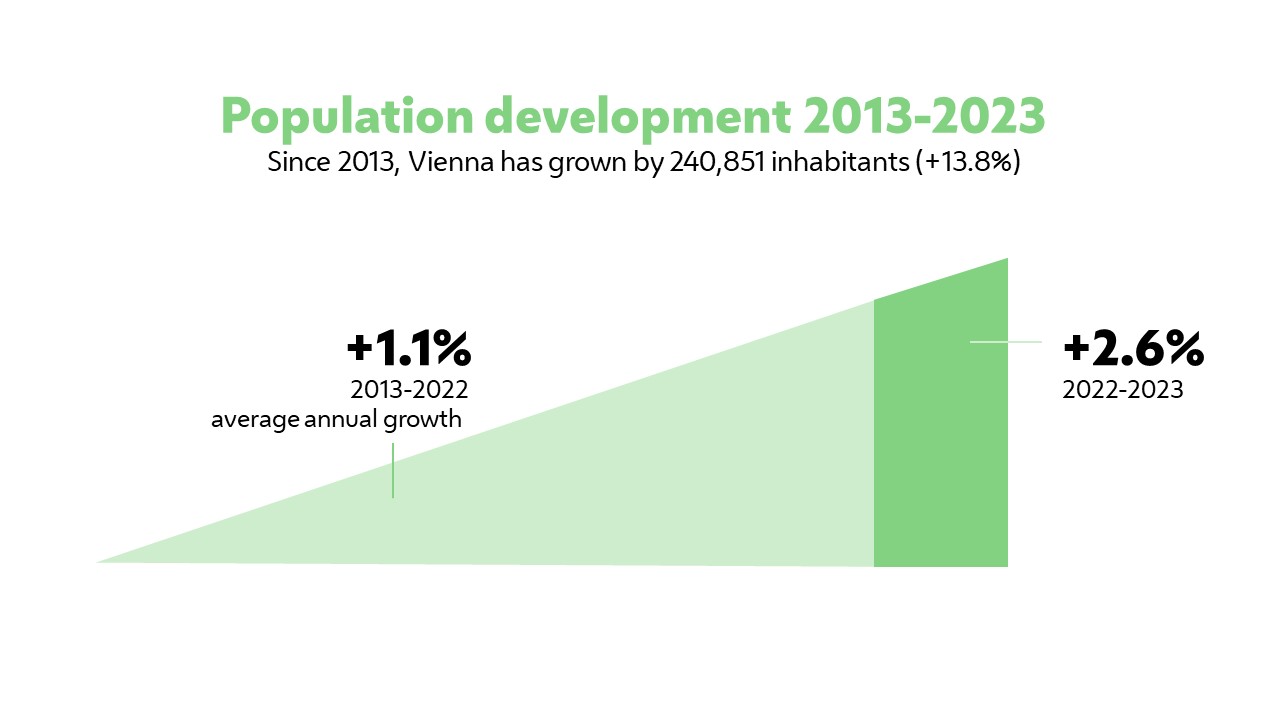CHALLENGES
A socially mixed, growing city
After more than a century, Vienna surpassed the two million population mark again in 2023. The capital of Austria is now the fifth largest city in the European Union after Berlin, Madrid, Rome and Paris, and the second largest city in the German-speaking world.
To meet the rising demand for housing, the Urban Development Plan (STEP 2025) defines a compound strategy combining urban expansion with compaction of the built stock. The prime objective lies in land-conserving urban development and the preservation of the high share of green spaces, which amounts to 50 percent of the municipal territory. For this reason, new urban development projects are to attain a density of 2.5 (gross development area); at the same time, existing urban quarters – especially those dating from the postwar period – are to be further developed.
Demographic change
Vienna is experiencing a process of demographic change: On the one hand, the average age of the urban population is decreasing; on the other hand, the number of older citizens is growing. Their specific needs, too, need to be considered, which is already underway in the housing sector. However, these efforts need to be further intensified by applying even more targeted approaches in the near future to take account of the very different lifestyles of various age groups.
A socially mixed city
Since the 1920s, the City of Vienna has been providing social housing across the entire city. The share of social housing (i.e. municipal flats and dwellings constructed by non-profit or limited-profit developers) ranges from 10 percent in the 8th municipal district to 65 percent in the 11th municipal district of Vienna.
Until the early 2000s, it was still possible to find inexpensive rents in low-standard dwellings dating back to the Gründerzeit era. However, this segment has been continuously dwindling since the 1970s due to rehabilitation and modernisation measures. For this reason, recent years have seen the development of various strategies, such as the SMART housing construction programme or the resumption of municipal housing construction as “Municipal Housing NEW”, to counteract this trend and provide more affordable dwellings in new buildings.
Climate protection and climate change
The challenges of climate change and climate protection to which Austria is committed on the basis of e.g. the Kyoto Protocol or the Paris Agreement create enormously difficult tasks for the housing sector both with regard to urban renewal and the construction of new buildings.
Vienna has had an ambitious climate protection program (kliP Vienna) for over 20 years, and it has been very successful ever since. Through a mix of different measures, Vienna’s housing sector contributes significantly towards this goal.
For further information (leaflet also in English)
www.wien.at/umwelt/klimaschutz
Building Rehabilitation stimulates the economy, increases housing quality and reduces the environmental footprint of Vienna.
The THEWOSAN funding scheme (integrated thermal-energy renovation of residential buildings), which is implemented in the refurbishment of municipal housing estates, contributes significantly to environmental protection by curbing energy consumption.
A residential building insulated according to the THEWOSAN principles consumes about 50 percent of space-heating energy less than a building without this type of insulation. The effects of THEWOSAN are reflected in lower space-heating costs for the residents of houses renovated according to this programme. The use of eco-friendly energy resources and heating systems helps to cut down on approx. 304,000 tonnes of CO2 annually.
For further information (in German)
http://www.wohnfonds.wien.at/erstinfo_thewosan
http://www.wohnfonds.wien.at/sanierung1

